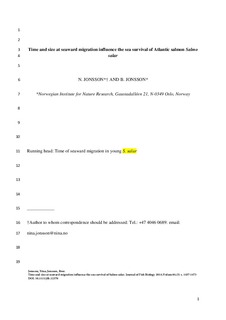| dc.contributor.author | Jonsson, Nina | |
| dc.contributor.author | Jonsson, Bror | |
| dc.date.accessioned | 2018-01-19T10:04:35Z | |
| dc.date.available | 2018-01-19T10:04:35Z | |
| dc.date.created | 2014-05-16T15:29:17Z | |
| dc.date.issued | 2014 | |
| dc.identifier.citation | Journal of Fish Biology. 2014, 84 (5), 1457-1473. | |
| dc.identifier.issn | 0022-1112 | |
| dc.identifier.uri | http://hdl.handle.net/11250/2478316 | |
| dc.description.abstract | Whether time of seaward migration of young Atlantic salmon Salmo salar influences their subsequent survival and growth was investigated in the River Imsa, south-western Norway. Salmo salar were tagged when moving downstream through a trap near the outlet between 1976 and 2010 and recaptured on their adult return.Most descended as smolts in April and May, but some descended during the other months of the year. Annual variation in timing of the smolt migration was significantly correlated with variation in water temperature during spring. Mean total body length of the descending S. salar varied with month of seaward migration. The sea survival of S. salar emigrating from the River Imsa between January and May was 2⋅8 times higher than for those descending between June and December. The sea survival of the various cohorts decreased with increasing river temperature in April to May, prior to the smolt migration, and decreasing day number when the smolts moved to sea. The size of smolts descending the river between April and May did not affect the survival at sea as much as it affected the survival of migrants descending in any other month of the year. The majority of the downstream migrating S. salar were 2 years old, but proportionally, more 1 year olds moved downstream in the autumn than in the rest of the year.Mean duration between downstream migration of the young and the return migration of the grilse was shortest (12⋅7 months) for those descending in July and August and longest for those descending in October (21 months). Mean monthly specific growth rate was highest for those migrating downstream between May and July and lowest for those emigrating in September. Based on the present results, it was hypothesized that S. salar emigrating between April and August migrated directly out into the ocean, while those that emigrated between October and March stayed in the estuary until the subsequent spring. © 2014 The Fisheries Society of the British Isles post-smolts; recapture rate; sea growth; seasonal seaward migration; water temperature. | |
| dc.language.iso | eng | |
| dc.title | Time and size at seaward migration influence the sea survival of Salmo salar | |
| dc.type | Peer reviewed | |
| dc.type | Journal article | |
| dc.description.version | acceptedVersion | |
| dc.source.pagenumber | 1457-1473 | |
| dc.source.volume | 84 | |
| dc.source.journal | Journal of Fish Biology | |
| dc.source.issue | 5 | |
| dc.identifier.doi | 10.1111/jfb.12370 | |
| dc.identifier.cristin | 1133183 | |
| dc.relation.project | Andre: Directorate for Nature Management | |
| dc.relation.project | Norges forskningsråd: 225014 | |
| dc.relation.project | Egen institusjon: NINA | |
| cristin.unitcode | 7511,6,0,0 | |
| cristin.unitname | Oslo | |
| cristin.ispublished | true | |
| cristin.fulltext | postprint | |
| cristin.qualitycode | 1 | |
